
Forecasts Made Ten Years Back
In January 2005, which is exactly ten years back from today, I wrote two articles forecasting future economic conditions. They were not publishable in mainstream academic economics journals, because it was not fashionable to predict deflation in 2005. The fashionable thing to say at that time was that the Federal Reserves would print money to avoid any deflation.
I post the articles below along with four charts and a few recent articles from mainstream media. You be the judge about how good or bad the forecasts came to be.
-————————————————–
A common misconception propagated by many sources is that US Federal Reserve has been printing tons of dollars to get us out of economic worries and start smiling again. Some even alluded that they put these dollars into small packets with “don’t worry, be happy” notes on the top and have been dropping them around our houses in the middle of the night from black, quiet helicopters. After my wife knew about it, I got into big trouble. She made me go and check around our house at wee hours, to find out whether my suspicious- looking neighbor was taking all my packages away. Needless to say, I had little luck catching him.
Now I have come up with this elaborate excuse to explain her that there was really no packet. If you are in the same boat as me and had to conduct unusual nocturnal activities for last one year, please feel free to use this excuse to avoid further trouble.
Let me get into my usual Aesop mode and use a small story to tell you what is really happening. Imagine you are a university student in desperate need of a car. Of course you do not have much money to buy one. Someone told you about a car auction where you could buy good cars at reasonable prices. You went there taking all the money you saved from your job at the university library. That was 2000 dollars of student money.
The auction was big and several cars caught your attention. However, you found out that the rules of payment were very strict. If you won a car, you had to pay for it in full cash right away. The bids were low because most people did not bring much cash. You saw this beautiful Audi going away for just 6000 dollars and you could do nothing. You did not carry enough cash.
The auction companies get commission as a percentage of the closing price. If closing price is low, they have less to take home as well. The manager noticed that the bids were too low and decided to change the rules of payment. He announced that the winner could bring the cash by next day. There would be a small fee for those who used that option but still it was really a small price for the convenience.
This change in payment option started to raise the bids. Poor you still figured that the Audi was out of your reach because you did not have the money in bank either. What if the auction manager changed the rule to allow you to pay within next five years? You knew that the job market is good and you were graduating in six months anyway. You could pay for that car comfortably. Would the manager believe your word that you could land a job so easily? Let us assume he did. Hence you chose to bite. The same was true for many others and you ended up in a bidding war. Finally you left with the Audi paying 8500 dollars for it, a price four times you could afford.
Notice here that the auction manager did not put small packets of money in your pocket to help you bid higher. All he did was just change the rules for payment. Rest was your conscious decision to borrow from your own future. Two conditions had to be satisfied for you to agree to borrow:
(i) Manager’s willingness to change the rules,
(ii) Your gut feeling that the future job prospects were going to be bright and the manager’s faith in it.
US economy is an auction at a grander scale. The managers at the Fed change the rules of the game and induce you to borrow from your future to pay for current pleasures. They do not need to drop money from helicopters to help you buy wine instead of diet Coke. Also when the rules are relaxed, prices go up. This increase in price comes from your decision to do spend both your 2004’s and 2005’s Christmas money to do this year’s shopping. That is the key to understanding why the housing prices have been going up at double-digit rates and where all the money is coming from. It is coming from our ability to get mortgage much easier than before, with questionable job prospects and our willingness to borrow more percentage of our current income. This is credit expansion, not printed money in our pocket.
That brings us to the core of the inflation/deflation debate. What is the future path for this kind of credit expansion? Going back to the car auction, can the manager continue relaxing the rules and thus keep getting higher bids? There is a point when he may have gone too far. At that point, many who bought cars with borrowed money will not be able to pay. Then he has to tighten the rules to take care of two things: (i) avoid additional losses, (ii) compensate for money he already lost.
In the broader economic perspective, there are additional effects to consider. As more people decided to borrow to buy car or house or wine, more auto factory workers, house-builders and wine-makers were hired. Since this money is borrowed or rather taken from the future, these jobs are also taken from the future. As you decide to spend your 2030’s income on that SUV now, jobs from 2030 also get completed now. Once the system goes too far to one extreme so that there is much speculative borrowing, defaults will rise and lenders will start to tighten rules due to higher defaults. This will cause more people to lose their ability to spend future money, more job losses and more defaults. This vicious cycle is likely to continue to the other extreme, if history is of any guidance.
All I explained so far is Fisher’s debt-deflation theory. Can today’s Fed do something new to make it stop happening? The short answer is no. There are two reasons. Firstly, Fed is prisoner of market forces. In the collective memory of market participants 70’s inflation ring more alarming bell than 30’s deflation. If there is any hint of inflation, there will be collective clamor from the market for the Fed to take action as there currently are. Response to deflation, on the other hand, will be less muted. Even if the Fed manages to fool the market, they do not lend money to people by themselves. Their role is in changing the rules so that other banks can lend easily. These are private banks conducting business. Why will these banks lend money and why will you want to borrow money, if you know that you have to continue as student for next five years and there is no certainty about job after that?
The only thing I can expect looking forward is deflation. People borrowed from their future, believing that the future will be good. Once this assumption turns false, there will be more and more unwillingness to borrow, as well as more destruction of previous debts through defaults and bankruptcies. Credit- based economies show inflation during the credit expansion phase (such as now), but once the credit expansion phase comes to an end, there is deflation on the other side of the slippery slope.
-————————————————
Nonlinearity, Memory Effect and the Markets
At the super-simplistic level, all natural phenomena around us can be classified into two categories: linear and non-linear. Linear systems are easy to understand. Suppose we need to rotate the valve of the shower by 5 degrees to make the water a bit warm. We expect that to get the water warmer by the same amount, the valve needs to be turned by another 5 degrees.
Nonlinear systems are more complex. You probably have used a compass that has a small magnet inside. Left by it, the magnet orients in the north-south direction, where the pole painted red always points to the north. Do you know that it is possible to change the north-south polarity of a tiny magnet, so that red pointer starts to show south? Here is how. Hold the small magnet tight and then bring it under the influence of another much more powerful magnet. If relative orientations are right, the powerful one will force the weak one to reverse its north-south poles.
In real life, an electric coil takes the place of the powerful magnet. Electric coil can act as magnet, when you pass current through it. Modulating the level of current varies its strength. Strange thing happens when we use this to reverse polarity of a tiny magnet. If the electric current is gradually increased from zero, the small magnet under its influence shows no change for a while. When the magnetic strength of the coil crosses a threshold, all of a sudden the tiny one reverses polarity. You do not want your shower to behave this way, spraying cold water on you while you keep turning the knob and then all of a sudden starting to pour hot, boiling water on your body!!
The magnet is an example of how nonlinearity manifests in nature and there are plenty more. The world around us is highly nonlinear and so are the financial markets. However, our mind is not trained to think or expect nonlinearity. We assume everything is linear or quasi-linear. When we make projections about the future, we extend the past. Longer the trend persists, the stronger foothold it grabs in our mind. “Technology companies have been doing well for last ten years.
Therefore they must be good for another ten years.” “House prices have been going up from 1980s. Therefore, it must go up for another 20 years” (or translate that to ‘ever’).
Properties of the nonlinear systems sometimes deceive us to think that way. Nonlinear systems almost always act as linear ones except when they make abrupt moves. In case of the magnets in our example, initially when we kept increasing the magnetic force on the tiny magnet, nothing happened for a long time until the sudden change of polarity took place. For financial world, these abrupt movements are so few in number, they often are excused as someone else’s fault, Saudis or Enron or whichever scapegoat is coincidentally present at that time.
Of course there are old and educated people with experience, who understand the system by actually getting burnt through a previous attack of market nonlinearity. They do take protections. Only problem is that for many, the memory comes from the previous episode and the protections are also taken for the same. In the collective minds of nation’s experts, 70’s inflation was the previous episode of 10-year financial disturbance. Therefore, majority of experienced people will try to warn us about the dangers of inflation. Those who went through 30’s deflation are far fewer in number and rarely in positions of influence now. In my opinion, deflation is the abrupt move we are least prepared for, but that is the most likely path US economy is ready to follow.
This is how the world behaves and will continue to behave forever, or at least until our minds are ready to project nonlinearly.
Nonlinearities and cycles are everywhere in nature. Long-wave economic cycles of stability, inflation, stability, deflation will continue. Students of history will amuse themselves by observing these recurring patterns of human stupidity and regained wisdom.
-—————————————-
The mainstream economists predicted that Fed would print money to destroy US dollar and US government bond. Interest rates would skyrocket as a result. You can see how wrong they were.
Interest rates on long-term bonds never stopped falling. This is the biggest indicator of deflation.
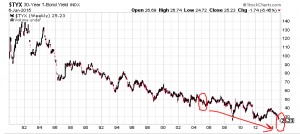
Long term treasury bonds rose as a result.
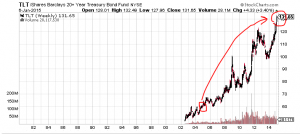
‘Destroyed’ US dollar is quite a bit higher now than in 2005.
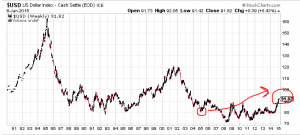
The mainstream economists also predicted that oil and commodity prices would skyrocket due to Fed printing money and resulting hyperinflation.
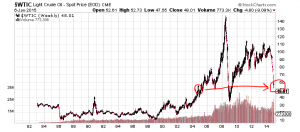
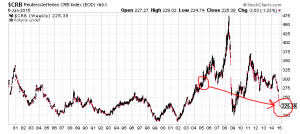
Here is what the mainstream economists are saying now.
Deflation Threatens Europe in 2015
The threat of deflation has taken centre stage as 2015 gets under way. But a robust response from the Swiss National Bank (SNB) and expectations for more of the same from the European Central Bank (ECB) reaffirm our positive view on European assets in the year ahead.
The SNBs move to negative interest rates announced in late December shows the level of worry about deflation, a concern shared by eurozone policymakers. ECB President Mario Draghi rang in the new year by highlighting Europes fight against this risk, which he said cannot be entirely excluded, though it is limited. Draghi hinted that aggressive quantitative easing would be the weapon of choice, saying we have to act against such a risk.
Deflation is a rising threat for markets
The world is prey to the growing problem of deficient demand
Why did so many market pundits fail to foresee the decline in yields across the developed world in 2014?
The short answer is that they were obsessed with the potential impact of the US Federal Reserves retreat from unconventional measures while neglecting the importance of global imbalances. In effect, the world has been prey to a growing problem of deficient demand, leading to disinflation, while the US has been growing too sedately to spark the inflationary pressures that would have called for much tighter monetary policy. There is a risk that forecasters will make the same mistake in 2015.
They have seen nothing yet !!
Back to bioinformatics.